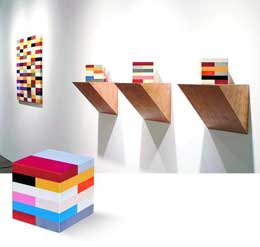Artist Makes Colorful Statement
By Kyle MacMillan, DENVER POST.COM
Welcome back, color.
With the worship of sociopolitical polemics and high-minded conceptualism and supposed death of painting at the end of the 20th century, color became something of a quaint anachronism.
But those days are gone. In the rambunctiously eclectic art world of today, painting is suddenly back in vogue and red, blue, yellow and all their kin are making a comeback.
The Aspen Art Museum marked this welcome development earlier this year with an intelligent, insightful survey titled “Like Color in Pictures.” Though not among the 20 international artists represented, Pard Morrison’s paintings and sculptures would have fit right in.

"50 Ways to Fall in Love", 2007, Gallery Left: "Flower 1", 2007
Morrison, 32, a near-lifelong resident of Colorado Springs, is showcased in “50 Ways to Fall in Love,” an exhilarating solo exhibition.
With this smart, sophisticated body of work — 24 pieces in all — this major young talent has arrived. He has become, quite simply, one of the states’ top abstract artists.
While his basic working method remains the same — color pigment baked onto aluminum — Morrison, to his credit, has matured beyond earlier pieces that consisted primarily of long bands of color on groups of horizontal or vertical bars.
Unlike those previous pieces, which were constraining and a bit forced in their way, these new offerings use the full spectrum of colors and an array of subsets thereof and incorporate a much richer array of compositional structures.
Morrison served as an assistant to famed minimalist painter Agnes Martin and was significantly influenced by her in many ways, including his titles, such as “Love Prayer” or “You’re So Lovely,” which are distractingly sentimental verging on cloying.
His work traces its roots to that often blurred realm between minimalism and geometric abstraction and is perhaps best described as post-minimalist. Morrision prefers the appellation “human minimalism.”
Both of these latter terms suggest a minimalist aesthetic without the austerity and severity and even coldness that is sometimes associated with that word.
Morrison welds the variously sized aluminum panels and cubes he uses for all his creations and then bakes multiple layers of color pigment onto them in a process that he calls “patination.”
While the edge of each section of color is sharply defined, the application of color often has a kind of soft, painterly effect, with some of the gray from the aluminum seeping through.
This technique, which can look at times like certain ceramic glazes, is a defining quality of these works, separating them from the rigorous look of hard-edged abstraction and imbuing them with a warmer human touch.
Strong selections abound in this show, none more striking than “Walking with Love” (2007), a prototypical example. This 60-inch-square panel is divided into 30 symmetrical horizontal stripes, dominated by white, tan and especially gray, with other accenting colors along the way.
In “The Cape in My Closet” (2007), a 12-by-60-inch panel, Morrison makes the stripes vertical, lining up 30 of them, using the full spectrum of colors in this bright, lively work.
Paintings take on many other shapes and sizes, with color segmented and sectionalized in an array of ways. In “Let Fall the Flowers From Your Hair” (2007), for example, a third of the composition is an open, gray field and the rest is a checkerboard pattern of color.
In addition to the wall panels, Morrison has created a number of sculptural works, all constructed and painted in the same manner. Three such 6-inch cubes are displayed on a row of wall pedestals, including the most colorful, “Flower 1.”
This is a defining show that marks Morrison as a Colorado artist to watch.
